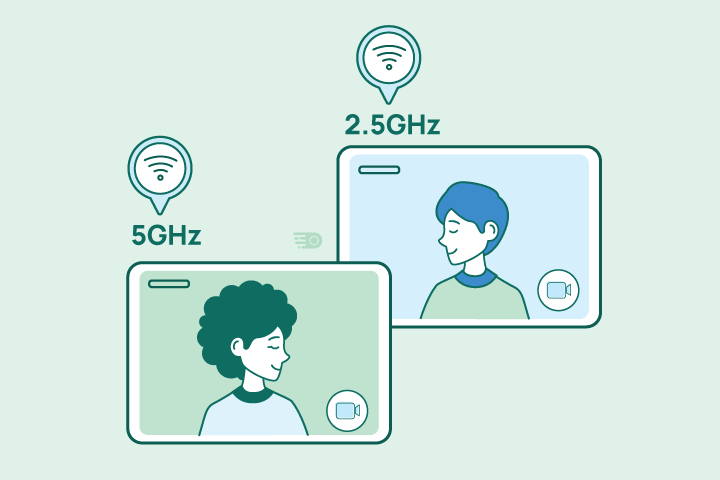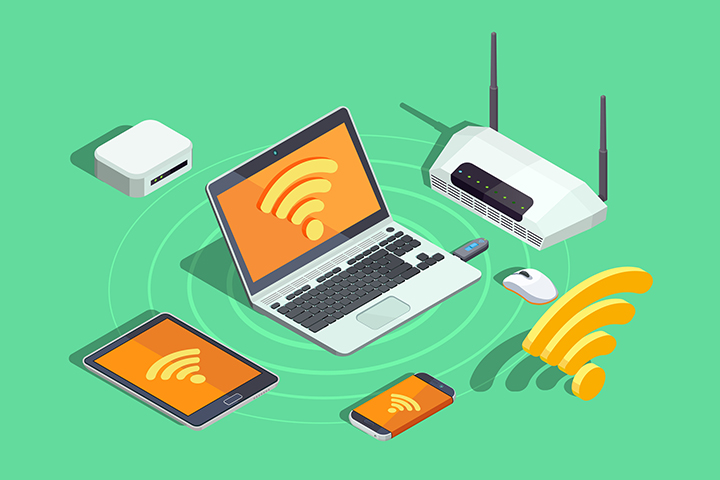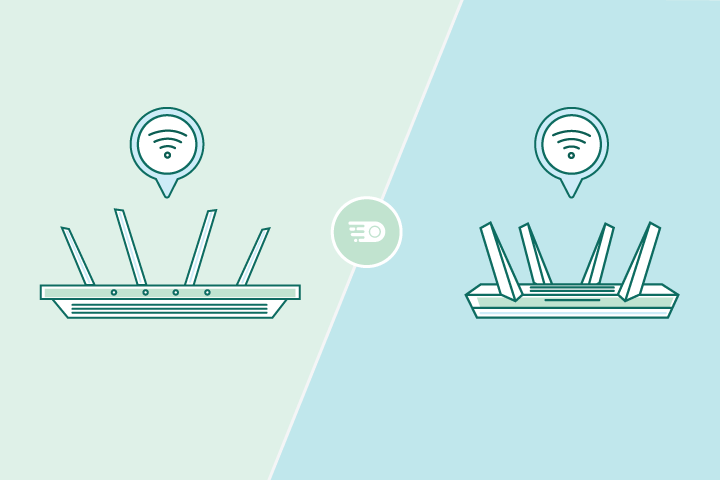2.4 vs 5 GHz WiFi: What’s the Difference

HighSpeedOptions prides itself on providing honest, quality content. While we may be compensated when you make a purchase through links on our site, all opinions are our own. Here's how we make money.
Table of Contents
Are you having issues with your WiFi? If you’re experiencing connectivity issues, consider running a wifi speed test and try switching up the way you access your home network on different devices.
For example, most routers today have dual-band technology that allows users to switch between 2.4 GHz and 5 GHz frequency bands, which usually increases internet speed. We explain the main differences between the two bands to help you know what scenarios each works best for.

Interference and Wi-Fi Channels
One important aspect to consider, especially for 2.4 GHz Wi-Fi, is the potential for interference. This band is more susceptible to interference from other household devices like microwaves and cordless phones. Additionally, within the 2.4 GHz band, there are multiple channels, and your router selects one automatically. If neighboring routers use the same channel, it can lead to interference and a weaker signal. Switching channels might help improve your Wi-Fi performance, especially in densely populated areas like apartment buildings.
Differences Between 2.4 GHz and 5 GHz
If you have a wireless router (802.11n or newer), chances are it supports two separate radio frequency bands: 2.4 GHz and 5. GHz. The main distinctions between these two bands comes down to wireless range and network speed.
Each band has strengths and weaknesses, which we explain in detail below.
GHz and Network Generations
WiFi networks use radio signals in different frequency lengths (i.e 2.4 GHz) to transmit data between routers and smart devices.
Depending on your internet service provider network, there are different standards, or “generations,” of WiFi technology that support faster speeds. In order of release, existing standards include:
- 802.11b (WiFi 1)
- 802.11a (WiFi 2)
- 802.11g (WiFi 3)
- 802.11n (WiFi 4)
- 802.11ac (WiFi 5)
- 802.11ax (WiFi 6)
Many assume a 5 GHz network performs better because it’s a “newer technology.” But this is a myth. Both 5GHz and 2.4 GHz networks were certified in 1999. However, it wasn’t until 2013 that WiFi became popular thanks to the release of WiFi 5 (i.e. 802.11ac). This network standard uses dual-band wireless technology to support simultaneous connections on both 2.4 GHz and 5 GHz bands.
GHz and Network Speed
The first key differentiator of the two bands is network speed. A 5 GHz network can carry almost twice as much data per unit of time as a 2.4 GHz network, which makes it faster.
To put it another way, the wavelengths of a 5 GHz frequency band are half the length of a 2.4 GHz frequency band, allowing it to carry more data over shorter distances.
For this reason, devices that require more bandwidth, like gaming consoles and streaming plugins, typically run faster on 5 GHz networks. Conversely, home devices like smart appliances and phones that don’t require as much bandwidth, work just fine on 2.4 GHz networks.
GHz and Network Range
The second key differentiator of the two is network range. A 5 GHz network generally supports faster speeds, but by design, it cannot reach as far as a 2.4 GHz signal. The higher the frequency of the wireless signal, the shorter its range. Therefore, a 2.4 GHz network usually covers a larger surface area than 5 GHz does.
In addition, 5 GHz wavelengths are more prone to collide with other objects (i.e. furniture, walls, etc.), which interferes with its signal. In contrast, 2.4 GHz wavelengths travel farther distances and can penetrate solid objects.
For this reason, a 5 GHz network is better suited for stationary devices like TVs and gaming consoles that don’t require much range, while a 2.4 GHz network works best with phones, alarm systems, and smaller devices that don’t require much bandwidth.
Optimizing Router Settings for Different Bands
To maximize your Wi-Fi experience, consider optimizing your router settings. For 2.4 GHz, selecting a less crowded channel can significantly reduce interference. For 5 GHz, ensure your router is positioned in a central location to maximize its shorter range. Most modern routers offer settings that can help you optimize each band based on your usage and environment.
Choosing Between Bands

In general, what one band excels at the other one lacks, and vice versa. So, the question isn’t, “Which one is better?” The question is, “When should I use them?” We outline a few things to consider when choosing between wireless bands.
1. Size of your home
As we discussed above, the higher the frequency of a network, the shorter its range. So, larger households (usually 1,500 sq. ft. or bigger) tend to benefit from a 2.4 GHz band since they require a greater coverage area. On the other hand, if you live in a smaller home or apartment, 5GHz will deliver faster speeds and eliminate dead spots with ease in most instances.
2. Types of devices
Ideally, you want to use the 2.4 GHz band for devices that require low bandwidth, like smartphones, home security systems, and garage openers. On the other hand, if you stream videos on an Amazon Firestick or have a gaming console, 5 GHz supports high-bandwidth devices best.
3. How devices are being used
Similarly, you’ll want to consider what you’re using your devices for. Certain online activities likie streaming movies can generate and consume more bandwidth than others, regardless of whether you’re on a desktop computer or your smartphone. For example, if you use your phone to check emails, connected to a 2.4 GHz network will suffice. However, using your phone to stream YouTube videos will require more bandwidth, which a 5 GHz network is best for.
Key Takeaway
All in all, choosing which band to use really depends on the situation. 2.4 GHz and 5 GHz networks each have their own advantages, and it’s important to take into account multiple factors like your home size, devices, and online activity when determining the right solution for you.
The best part about having a dual-band router is that you can also divvy up bandwidth, connecting different devices to both bands simultaneously. This helps reduce possible network congestion overall.
That said, if you still experience problems with your WiFi connection, you may want to also consider boosting your signal with WiFi extenders or upgrading your internet plan to include higher speeds.
Find providers in your area
Table of Contents





